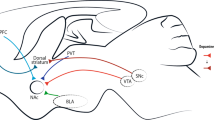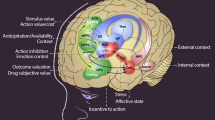Abstract
What is the disease that affects more than 30 million individuals in the United States and Europe, is a leading cause of death and costs 2–3.5% of gross domestic product? The answer — alcohol abuse and drug addictions — still surprises many, and in general, addictions are undertreated. But advances in the understanding of the underlying biology and clinical manifestations of addictions are creating new opportunities for the development of novel pharmacotherapies to complement psychosocial interventions.
This is a preview of subscription content, access via your institution
Access options
Subscribe to this journal
Receive 12 print issues and online access
$209.00 per year
only $17.42 per issue
Buy this article
- Purchase on Springer Link
- Instant access to full article PDF
Prices may be subject to local taxes which are calculated during checkout


Similar content being viewed by others
References
Sindelar, J. L. & Fiellin, D. A. Innovations in treatment for drug abuse: solutions to a public health problem. Am. J. Public Health 89, 385–390 (1999).
Stein, J. J. (ed) Substance Abuse: The Nation's Number One Health Problem (Schneider Institute for Health Care Policy, Robert Wood Johnson Foundation, Princeton, New Jersey, 2001).
Nestler, E. J. Molecular neurobiology of addiction. Am. J. Addict. 10, 201–217 (2001).
Smith, D. E. & Seymour, R. B. Clinician's Guide to Substance Abuse (McGraw Hill, 2001).
O'Brien, C. & Fischman, M. W. in Neuropsychopharmacology: The Fifth Generation of Progress (eds Davis, K. L., Charney, D., Coyle, J. T. & Nemeroff, C.) 1355 (Lippincott Williams & Wilkins, Philadelphia, 2002).
Kopnisky, K. L. & Hyman, S. E. in Neuropsychopharmacology: The Fifth Generation of Progress (eds Davis, K. L., Charney, D., Coyle, J. T. & Nemeroff, C.) 1366 (Lippincott Williams & Wilkins, Philadelphia, 2002).
Grant, E. et al. Epidemiologic bulletin no. 35: prevalence of DSM-IV alcohol abuse and dependence, United States 1992. Alcohol Health Res. World 18, 243–246 (1994).
Caetano, R. & Cunradi, C. Alcohol dependence: a public health perspective. Addiction 97, 633–645 (2002).
Ames, G. M., Cunradi, C. B. & Moore, R. S. Alcohol, tobacco, and drug use among young adults prior to entering the military. Prev. Sci. 3, 135–144 (2002).
Knight, J. R. et al. Alcohol abuse and dependence among US college students. J. Stud. Alcohol 63, 263–270 (2002).
Rhodes, W., Layne, M., Johnston, P. & Hozik, L. What America's Users Spend On Illegal Drugs 1988–1998 (Office of National Drug Control Policy, Washington, 1999).
European Monitoring Centre for Drugs and Drug Addiction. Annual Report on the State of the Drugs Problem in the European Union 2001. European Monitoring Centre for Drugs and Drug Addiction [online] (cited 01 Aug 2002) 〈http://annualreport.emcdda.org/multimedia/Annual_Report_2001/ar01_en.pdf〉 (2001).
Hartnoll, R. in European Monitoring Centre for Drugs and Drug Addiction. Estimating the Prevalence of Problem Drug Use in Europe. (EMCDDA Scientific Monograph No. 1) 247–261 (Office for Official Publications of the European Communities, Luxembourg, 1997).
Frischer, M. in European Monitoring Centre for Drugs and Drug Addiction. Estimating the Prevalence of Problem Drug Use in Europe. (EMCDDA Scientific Monograph No. 1) 113–126 (Office for Official Publications of the European Communities, Luxembourg, 1997).
Strote, J., Lee, J. E. & Wechsler, H. Increasing MDMA use among college students; results of a national survey. J. Adolesc. Health 30, 64–72 (2002).
United Nations for Drug Control and Crime Prevention. United Nations World Drug Report 2000. United Nations Office for Drug Control and Crime Prevention [online] (cited 01 Aug 2002) 〈http://www.undcp.org/world_drug_report.html〉 (2000).
Cartwright, W. S. Costs of drug abuse to society. J. Ment. Health. Policy Econ. 2, 133–134 (1999).
French, M. T. & Martin, R. F. The costs of drug abuse consequences: a summary of research findings. J. Subst. Abuse Treat. 13, 453–466 (1996).
Office of National Drug Control Policy. The Economic Costs of Drug Abuse in the United States, 1992–1998 (Publication no. NCJ-190636) (Executive Office of the President, Washington DC).
New York State Office of Alcoholism and Substance Abuse Services (OASAS). The Costs and Consequences of Addiction and the Benefits of Prevention and Treatment. New York State Office of Alcoholism and Substance Abuse Services [online] (cited 01 Aug 2002) 〈http://www.oasas.state.ny.us/pio/cc_1998.pdf〉 (1998).
Harwood, H. J. Fountain, D. & Fountain, G. Economic cost of alcohol and drug abuse in the United States, 1992: a report. Addiction 94 631–635 (1999).
Fox, K., Merrill, J. C., Chang, H. H. & Califano, J. A. Jr. Estimating the costs of substance abuse to the Medicaid hospital care program. Am. J. Public Health 85, 48–54 (1995).
Single, E., Robson, L., Xie, X. & Rehm, J. The economic costs of alcohol, tobacco and illicit drugs in Canada, 1992. Addiction 93, 991–1006 (1998).
Mark, T. L., Woody, G. E., Juday, T. & Kleber, H. D. The economic costs of heroin addiction in the United States. Drug Alcohol Depend. 61, 195–206 (2001).
Harwood, H. J., Fountain, D. & Livermore, G. Economic costs of alcohol abuse and alcoholism. Recent Dev. Alcohol. 14, 307–330 (1998).
Wall, R. et al. Social costs of untreated opioid dependence. J. Urban Health 77, 688–722 (2000).
Reynaud, M., Gaudin-Colombel, A. F. & Le Pen, C. Estimation of health care cost for alcoholism in France: advantages and limitations of two evaluation methods. Presse Med. 28, 1653–1660 (1999).
Healey, A. et al. Economic burden of drug dependency. Social costs incurred by drug users at intake to the National Treatment Outcome Research Study. Br. J. Psychiat. 173, 160–165 (1998).
Devlin, N. J., Scuffham, P. A. & Bunt, L. J. The social costs of alcohol abuse in New Zealand. Addiction 92, 1491–1505 (1997).
Brecht, J. G., Poldrugo, F. & Schadlich, P. K. Alcoholism . The cost of illness in the Federal Republic of Germany. Pharmacoeconomics 10, 484–493 (1996).
Office of Applied Studies, Substance Abuse and Mental Health Services Administration. 1994–1999 Treatment Episode Data Set. Drug and Alcohol Services Information System [online] (cited 01 Aug 2002) 〈http://www.dasis.samhsa.gov/teds99/2_9.htm〉 (2001).
Gonzalez, G., Oliveto, A. & Kosten, T. R. Treatment of heroin (diamorphine) addiction: current approaches and future prospects. Drugs 62, 1331–1343 (2002).
National Consensus Development Panel on Effective Medical Treatment of Opiate Addiction. Effective medical treatment of opiate addiction. JAMA 280, 1936–1943 (1998).
Volpicelli, J. R. Naltrexone and alcohol dependence: role of subject compliance. Arch. Gen. Psych. 54, 737–742 (1997).
Smart, R. G., Mann, R. E. & Lee, S. L. Does increased spending on alcoholism treatment lead to lower cirrohsis death rates? Alcohol Alcohol 31, 487–491 (1996).
Volpicelli, J. R. Medications in the treatment of alcohol addiction. AlcoholMD.com [online] (cited 01 Aug 2002) 〈http://www.Alcoholmd.com/pro/medic/medications_for_alcoholism.asp〉 (2002).
Mason, B. J. Treatment of alcohol-dependent outpatients with acamprosate: a clinical review. J. Clin. Psychiat. 62, S42–S48 (2001).
Kranzler, H. R. & Van Kirk, J. Efficacy of naltrexone and acamprosate for alcoholism treatment. Alcohol Clin. Exp. Res. 25, 1335–1341 (2001).
Rubio, G., Jiminez-Arriero, M. A., Ponce, G. & Palomo, T. Naltrexone versus acamprosate: one year follow-up of alcohol dependence treatment. Alcohol Alcohol 36, 419–425 (2001).
George, T. P. et al. Disulfiram versus placebo for cocaine dependence in buprenorphine-maintained subjects: a preliminary trial. Biol. Pyschiat. 47, 1080–1086 (2000).
Rydell, C. P. & Everingham, S. S. Controlling Cocaine (Drug Policy Research Center, RAND Corporation, Santa Monica, California, 1994).
Adrian, M., Ferguson, B. S. & Her, M. Can alcohol prices be used to reduce drunk driving? Evidence from Canada. Subst. Use Misuse 36, 1923–1957 (2001).
Auriacombe, M., O'Brien, C. P. & Tignol, J. Buprenorphine in the treatment of opiate dependence. Ann. Med. Interne 145 (Suppl. 3), S27 (1994).
Ling, W. et al. Buprenorphine maintenance treatment of opiate dependence: a multicenter, randomized clinical trial. Addiction 93, 475–486 (1998).
Mello, N. K. & Mendelson, J. H. Buprenorphine suppresses heroin use by heroin addicts. Science 207, 657–659 (1980).
Thirion, X. et al. Maintenance treatment for opioid dependence in care centers: the OPPIDUM program of the evaluation and information centers for drug addiction. Ann. Med. Interne (Paris) 151, A10–7 (2000).
Mendelsohn, J. et al. Buprenorphine and naloxone interactions in opiate-dependent volunteers. Clin. Pharmacol. Ther. 60, 105–114 (1996).
Sobel, B. F., Liebson, I. A. & Bigelow, G. E. Prolonged opioid blockade by Depot Naltrexone (Naltrel). Drug Alcohol Depend. 63, S148–S149 (2001).
Goldman-Rakic, P. S., Muly, E. C. & Williams, G. V. D1 receptors in prefrontal cells and circuits. Brain Res. Brain Res. Rev. 31, 295–301 (2000).
Haney, M. et al. Effect of a selective dopamine D1 agonist (ABT-431) on smoked cocaine self-administration in humans. Psychopharmacology 143, 102–110 (1999).
Castner, S. A., Williams, G. V. & Goldman-Rakic, P. S. Reversal of antipsychotic-induced working memory deficits by short-term dopamine D1 receptor stimulation. Science 287, 2020–2022 (2000).
Giardina, W. J. & Willams, M. Adrogolide HCl (ABT-431; DAS-431), a prodrug of the dopamine D1 receptor agonist, A-86929: preclinical pharmacology and clinical data. CNS Drug Rev. 7, 305–316 (2001).
Pilla, M. et al. Selective inhibition of cocaine-seeking behaviour by a partial dopamine D3 receptor agonist. Nature 400, 371–375 (1999).
Stocker, S. Cocaine's pleasurable effects may involve multiple chemical sites. National Institute on Drug Abuse [online] (cited 01 Aug 2002) 〈http://165.112.78.61/NIDA_Notes/NNVol14N2/Cocaine.html〉 (1999).
Gerasimov, M. R. et al. γ-Aminobutyric acid mimetic drugs differentially inhibit the dopaminergic response to cocaine. Eur. J. Pharmacol. 395, 129–135 (2000).
Carrera, M. R., Ashley, J. A., Wirsching, P., Koob, G. F. & Janda, K. D. A second-generation vaccine protects against the psychoactive effects of cocaine. Proc. Natl Acad. Sci. USA 98, 1988–1992 (2001).
Volkow, N. D. & Fowler, J. S. in Neuropsychopharmacology: The Fifth Generation of Progress (eds Davis, K. L., Charney, D., Coyle, J. T. & Nemeroff, C.) 1475 (Lippincott Williams & Wilkins, Philadelphia, 2002).
Crespi, F. The role of cholecystokinin (CCK), CCK-A or CCK-B receptor antagonists in the spontaneous preference for drugs of abuse (alcohol or cocaine) in naive rats. Methods Find. Exp. Clin. Pharmacol. 20, 679–697 (1998).
Beinfeld, M. C., Connolly, K. J. & Pierce, R. C. Cocaine treatment increases extracellular cholecystokinin (CCK) in the nucleus accumbens shell of awake, freely moving rats, an effect that is enhanced in rats that aree behaviorally sensitized to cocaine. J. Neurochem. 81, 1021–1027 (2002).
Grabowski, J. et al. Risperidone for the treatment of cocaine dependence: randomized double-blind trial. J. Clin. Psychopharmacol. 20, 305–310 (2000).
Grabowski, J. et al. Dextroamphetamine for cocaine-dependence treatment: a double-blind randomized clinical trial. J. Clin. Psychopharmacol. 21, 522–526 (2001).
Martellotta, M. C. et al. Effects of the calcium antagonist isradipine on cocaine intravenous self-administration in rats. Psychopharmacology 113, 378–380 (1994).
Berger, S. P. et al. Haloperidol antagonism of cue-elicited cocaine craving. Lancet 347, 504–508 (1996).
Acknowledgements
We thank L. Moore, Associate Editor for www.AlcoholMD.com, and R. Seymour, Managing Editor for the Journal of Psychoactive Drugs, for their comments and suggestions.
Author information
Authors and Affiliations
Related links
Related links
DATABASES
LocusLink
Medscape DrugInfo
FURTHER INFORMATION
Encyclopedia of Life Sciences
Rights and permissions
About this article
Cite this article
Pouletty, P. Drug addictions: towards socially accepted and medically treatable diseases. Nat Rev Drug Discov 1, 731–736 (2002). https://doi.org/10.1038/nrd896
Issue Date:
DOI: https://doi.org/10.1038/nrd896
This article is cited by
-
Targeted exosome-mediated delivery of opioid receptor Mu siRNA for the treatment of morphine relapse
Scientific Reports (2015)
-
Neuropharmacology of addiction—setting the scene
British Journal of Pharmacology (2008)
-
Translational research in medication development for nicotine dependence
Nature Reviews Drug Discovery (2007)
-
Morphine and Heroin Differentially Modulate In Vivo Hippocampal LTP in Opiate-Dependent Rat
Neuropsychopharmacology (2007)



